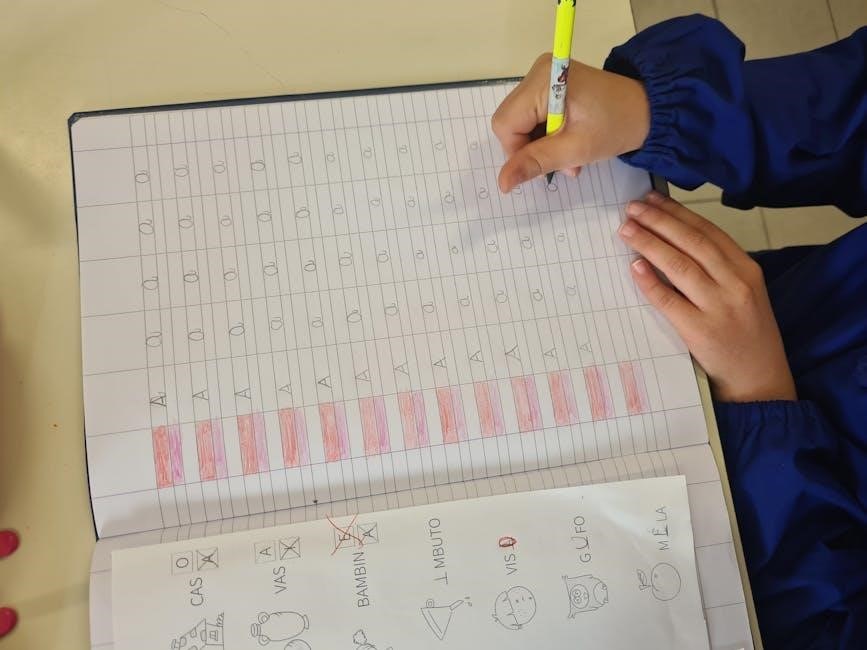Function worksheets are essential tools for introducing students to the concept of functions, offering interactive problems to understand domain, range, and function evaluation. They provide a structured approach to learning, making the topic engaging and effective for building a strong mathematical foundation.
1.1. Definition of a Function
A function is a relation where each input (x-value) corresponds to exactly one output (y-value). It can be expressed as ( f(x) = y ), where ( y ) is uniquely determined by ( x ). For example, in a linear function like ( f(x) = 2x + 3 ), each ( x ) maps to a single ( y ). Functions can also be represented graphically, where the vertical line test ensures that any vertical line intersects the graph at most once, confirming it as a function. This fundamental concept is crucial for understanding advanced mathematics.
1.2. Importance of Learning Functions
Mastering functions is fundamental for understanding advanced mathematics, as they form the basis of calculus, algebra, and other math disciplines. Functions help model real-world phenomena, enabling the representation of relationships between variables. They are essential for solving equations, graphing, and analyzing data. Worksheets on functions provide structured practice, helping students grasp these concepts through practical problems. This foundation enhances problem-solving skills and prepares learners for higher-level mathematical applications.
1.3. Key Concepts in Function Worksheets
Function worksheets focus on core concepts such as evaluating functions, determining domain and range, and identifying functions from graphs. They also cover function notation, composite functions, and inverse functions. These exercises provide practical problems to understand function behavior, transformations, and real-world applications. Worksheets often include graphing exercises to visualize function relationships, helping students connect algebraic and graphical representations. By practicing these concepts, students gain a solid foundation for advanced math topics like calculus and algebraic analysis.

Evaluating Functions
Evaluating functions involves substituting values into a function to find specific outputs. This skill is crucial for understanding function behavior and solving real-world problems efficiently.
2.1. Substituting Values into a Function
Substituting values into a function involves replacing the input variable with specific numbers to calculate the corresponding output. For example, in f(x) = 4x ─ 2, substituting x = 0 gives f(0) = -2. This process helps understand function behavior and is a fundamental skill for solving equations and real-world problems. Worksheets often include exercises like evaluating f(-3) or f(5), ensuring students master input-output relationships. Regular practice with substitution builds a strong foundation for more complex function topics.
2.2. Function Notation and Interpretation
Function notation, such as f(x), represents the relationship between inputs and outputs. It allows for clear communication of mathematical ideas. For instance, f(3) refers to the output when x = 3. Interpreting function notation involves understanding that f(x) = 2x + 3 means doubling the input and adding 3. Worksheets often include problems like evaluating f(-2) or interpreting f(5) = 10, helping students grasp input-output relationships and apply them to real-world scenarios effectively.
2.3. Solving for Specific Inputs and Outputs
Solving for specific inputs and outputs involves substituting values into a function to find unknown variables. For example, given f(x) = 2x + 3, to find f(3), substitute x = 3, resulting in f(3) = 9. Conversely, to find the input when the output is known, solve equations like 2x + 3 = 11 for x, yielding x = 4. Worksheets often include such problems, reinforcing the understanding of input-output relationships and preparing students for more complex function manipulations in algebra and calculus.

Domain and Range of Functions
The domain and range of a function define its input and output capabilities. Worksheets provide exercises to identify these, crucial for understanding function behavior and problem-solving.
3;1. Understanding Domain Restrictions
Domain restrictions define the allowable input values for a function. Worksheets help students identify these restrictions, crucial for function evaluation and graph interpretation. Examples include radical expressions, where the radicand must be non-negative, and rational functions, where denominators cannot be zero. These restrictions ensure functions behave predictably and avoid undefined outputs. By practicing with diverse problems, students master identifying domain limitations, enhancing their ability to analyze and graph functions accurately. This skill is fundamental for advanced topics like calculus and real-world applications.
3.2. Determining the Range of a Function
Determining the range involves identifying all possible output values a function can produce. Worksheets often include exercises where students analyze functions to find their minimum and maximum values. For linear functions, the range is typically all real numbers, while quadratic functions may have restricted ranges. By solving problems and graphing functions, students learn to identify the range, which is essential for understanding function behavior and applications in calculus and other advanced math topics, ensuring a comprehensive grasp of function properties.
3.3. Identifying Domain and Range from Graphs
Identifying the domain and range from graphs involves analyzing the function’s visual representation. The domain is determined by the x-values on the graph, while the range is identified by the y-values. Worksheets often include graph-based exercises where students observe the function’s behavior, noting restrictions like asymptotes or holes. By examining the graph’s boundaries and gaps, students can accurately determine the domain and range, enhancing their understanding of function limitations and behavior in various mathematical contexts through practical application.

Identifying Functions
Identifying functions involves determining if a relation represents a function. Worksheets provide exercises using the vertical line test, classifying relations, and identifying examples/non-examples. These activities enhance understanding by offering practical application of function concepts.
4.1. Using the Vertical Line Test
The vertical line test is a practical method to identify if a graph represents a function. By analyzing the graph, if any vertical line intersects the graph at more than one point, it is not a function. Worksheets often include multiple graphs for students to apply this test, ensuring they can visually assess and classify relations as functions or non-functions. This hands-on approach reinforces understanding of function criteria and their real-world applications in mathematics.
4.2. Classifying Relations as Functions
Function worksheets include exercises that require students to classify relations as functions by analyzing mappings, tables, and graphs. Each problem helps students determine if a relation is a function by ensuring each input corresponds to exactly one output. These activities enhance critical thinking and problem-solving skills, preparing students for advanced topics. By practicing with various representations, students gain confidence in identifying functions accurately, whether through vertical line tests or evaluating mappings, fostering a solid understanding of function fundamentals.
4.3. Examples and Non-Examples of Functions
Function worksheets often include examples and non-examples to help students distinguish between valid and invalid functions. For instance, linear relations like ( f(x) = 2x ) are clear examples, while relations with multiple outputs for a single input are not functions. These exercises use tables, graphs, and equations to illustrate key differences. By analyzing these cases, students develop the ability to identify functions accurately, enhancing their understanding of input-output relationships and preparing them for more complex function-related concepts in algebra and beyond.

Graphing Functions
Graphing functions involves plotting points to visualize relationships, identifying key features like intercepts and turning points, and sketching simple function graphs to understand their behavior.
5.1. Plotting Points on a Coordinate Plane
Plotting points involves mapping x and y values on a coordinate plane to visualize function behavior. Worksheets guide students in accurately placing points and connecting them to form function graphs, enhancing understanding of input-output relationships and graphical representations. This skill is fundamental for analyzing function characteristics and transformations, ensuring a solid foundation in graphing.
5.2. Identifying Key Features of Graphs
Function worksheets often include exercises on identifying key features of graphs, such as x-intercepts, y-intercepts, vertices, and asymptotes. These activities help students recognize patterns and understand how functions behave visually. By analyzing graphs, learners can determine maximum or minimum points, intervals of increase or decrease, and end behavior. This skill enhances their ability to interpret and describe functions accurately, making them proficient in understanding function properties and their real-world implications. Practice with graphs strengthens analytical and problem-solving abilities in mathematics.
5.3. Sketching Graphs of Simple Functions
Sketching graphs of simple functions is a fundamental skill in understanding function behavior. Worksheets often include exercises where students plot points and draw graphs for basic functions like linear, quadratic, and cubic equations. This practice helps learners visualize how functions operate, identify key features such as intercepts and turning points, and understand transformations. By sketching graphs, students develop the ability to analyze and interpret function behavior, making it easier to solve real-world problems involving mathematical modeling and data representation.

Transformations of Functions
Function transformations involve shifting, stretching, or reflecting graphs to alter their appearance. Worksheets often include exercises on vertical/horizontal shifts and compressions, helping students understand how transformations modify function behavior.
6.1. Vertical and Horizontal Shifts
Vertical and horizontal shifts modify a function’s graph by moving it up, down, left, or right. Worksheets often include exercises where students apply shifts to functions like f(x) + k (vertical) or f(x ─ h) (horizontal). These shifts alter the function’s equation without changing its shape, helping students visualize how transformations affect the graph’s position. Examples typically involve identifying the shift amount and graphing the transformed function, reinforcing understanding of how constants influence function behavior and graphical representation.
6.2; Stretching and Compressing Functions
Stretching and compressing functions involve altering the function’s graph vertically or horizontally by multiplying the input or output by a constant factor. Worksheets often include problems where students identify and apply these transformations, such as vertical stretches using y = af(x) or horizontal compressions using y = f(bx). These exercises help students understand how scaling affects the graph’s shape and behavior, preparing them for more complex function analyses and real-world applications in modeling and problem-solving scenarios.
6.3. Reflecting Functions Over Axes
Reflecting functions over the x-axis or y-axis involves transforming the graph to understand its symmetry and behavior. Worksheets often include exercises where students reflect functions using y = -f(x) for reflections over the x-axis or y = f(-x) for reflections over the y-axis. These problems help students visualize how reflections alter the function’s graph, enhancing their understanding of function transformations and their applications in real-world mathematical modeling and problem-solving scenarios. Practice with reflections builds foundational skills for analyzing more complex function behaviors.

Composite Functions
Composite functions involve combining two or more functions to create a new function, using notation like ( (f rc g)(x) = f(g(x)) ). Worksheets provide exercises to evaluate and simplify these functions, helping students master function composition and its applications in advanced mathematics and real-world problems.
7.1. Definition and Notation
A composite function, denoted as f(g(x)), involves applying one function g to an input and then applying a second function f to the result. Worksheets introduce this concept with clear examples and notation, helping students understand how to form and interpret composite functions. Practice exercises focus on defining composite functions and using correct notation to ensure a solid grasp of this fundamental topic.
7.2. Evaluating Composite Functions
Evaluating composite functions involves substituting outputs of one function into another. For example, given f(x) = x² + 2x + 1 and g(x) = x + 3, the composite function f(g(x)) becomes f(x + 3). Worksheets guide students through step-by-step substitution and simplification, ensuring understanding of nested functions. Practice problems emphasize proper substitution and algebraic manipulation, building proficiency in handling complex function compositions with precision and clarity.
7.3. Simplifying Composite Functions
Simplifying composite functions involves algebraic manipulation to combine functions effectively. Techniques include combining like terms and factoring. For instance, given f(x) = 2x + 1 and g(x) = x² + 3, the composite function f(g(x)) simplifies to 2(x² + 3) + 1 = 2x² + 7. Worksheets provide exercises to practice these skills, ensuring students master simplification for clearer function behavior understanding and better preparation for advanced mathematical concepts.

Inverse Functions
Inverse functions reverse the action of the original function, enabling solutions to equations and deeper understanding of function behavior. Worksheets provide exercises to find and verify inverses, enhancing problem-solving skills and mastery of function symmetry.
8.1. Finding the Inverse of a Function
Finding the inverse of a function involves reversing its operations to map outputs back to inputs. To find the inverse, replace ( f(x) ) with ( y ), swap ( x ) and ( y ), then solve for ( y ). Verify by ensuring ( f^{-1}(f(x)) = x ) and ( f(f^{-1}(x)) = x ). Worksheets provide step-by-step exercises to practice this process, ensuring mastery of function reversal and its practical applications in solving equations and understanding function symmetry.
8.2. Graphing Inverse Functions
Graphing inverse functions involves plotting points that are reflections of each other over the line ( y = x ). To graph an inverse function, identify key points of the original function and swap their ( x ) and ( y ) coordinates. For example, if ( (a, b) ) is on the original function, ( (b, a) ) will be on its inverse. Ensure symmetry across the line ( y = x ) and verify by checking that the inverse function passes the vertical line test. Worksheets often include exercises to practice identifying and sketching these reflections accurately.
8.3. Verifying Inverse Functions
To verify inverse functions, compose the function and its inverse to ensure the result is the identity function. For example, if ( f(g(x)) = x ) and ( g(f(x)) = x ), they are true inverses. Worksheets often include problems where students evaluate compositions and check for the identity function. This step confirms that the functions mirror each other correctly, reinforcing understanding of inverse relationships. Practice exercises typically involve algebraic verification and graphical confirmation, ensuring a thorough grasp of inverse function properties.

Applications of Functions
Functions are fundamental in real-world applications and advanced mathematics, appearing in calculus, geometry, and various everyday problems, making them a crucial topic for students.
9.1. Real-World Applications
Functions are integral to modeling real-world phenomena, such as motion in physics, growth in biology, and economic systems. They help describe relationships between variables, enabling predictions and problem-solving. From calculating distance-time graphs to analyzing population growth, functions provide a mathematical framework for understanding complex systems. Function worksheets often include practical problems that simulate real-life scenarios, allowing students to apply theoretical knowledge to tangible situations, thereby reinforcing their understanding and preparing them for future applications in diverse fields.
9.2. Functions in Calculus
Functions are fundamental in calculus, serving as the foundation for differentiation and integration. Function worksheets help students master essential skills like function notation, evaluation, and graphing, which are critical for understanding calculus concepts. These exercises prepare learners to analyze rates of change, accumulate quantities, and model real-world phenomena mathematically. By practicing with worksheets, students build the proficiency needed to apply calculus principles to various functions, ensuring a smooth transition into advanced mathematical studies.
9.3. Functions in Other Math Topics
Functions are integral to various math disciplines beyond calculus, such as algebra, geometry, and trigonometry. Function worksheets often include problems involving quadratic, exponential, and polynomial functions, which are essential in these fields. They help students understand how functions model relationships and transformations, a key concept in geometry. Additionally, trigonometric functions are explored in depth, preparing learners for advanced topics like periodicity and wave analysis. These exercises ensure a well-rounded understanding of functions across mathematics, fostering problem-solving skills and mathematical fluency.

Practice Resources
Free PDF worksheets, online platforms, and study guides offer extensive practice resources for mastering functions, ensuring comprehensive understanding and skill development through varied exercises and interactive tools.
10.1. Free PDF Worksheets
Free PDF worksheets are an excellent resource for practicing function-related problems. They cover a wide range of topics, including domain and range, evaluating functions, and graphing. These worksheets are designed to help students gradually improve their skills, starting from basic concepts to more complex problems. Many websites, such as Cuemath and Kuta Software, offer downloadable PDFs that cater to different difficulty levels. Students can use these worksheets to reinforce their understanding and prepare for exams or quizzes. They are also ideal for self-paced learning, allowing students to practice anytime and anywhere.
10.2. Online Practice Platforms
Online platforms like IXL, Kuta Software, and others offer interactive exercises for practicing function-related concepts. These tools provide instant feedback, allowing students to track their progress and identify areas for improvement. Many platforms feature a variety of difficulty levels, catering to both beginners and advanced learners. With access to thousands of problems, students can refine their skills in evaluating functions, determining domains and ranges, and graphing. These resources are particularly useful for self-paced learning, enabling students to practice anytime and enhance their understanding of functions through engaging and challenging exercises.
10.3. Recommended Study Materials
Recommended study materials include free PDF worksheets from reputable sources like Cuemath and IXL, offering structured problems on functions. These resources provide comprehensive coverage of topics such as evaluating functions, determining domains, and graphing. Additionally, guided examples and step-by-step solutions help students understand complex concepts. Flashcards and study guides are also useful for reinforcing key terms and definitions; By utilizing these materials, students can master functions and build a strong foundation for advanced math topics.
Mastering functions is achievable through consistent practice and structured learning. Worksheets provide an effective way to build a strong foundation, essential for advanced math topics and problem-solving skills.
11.1. Summary of Key Concepts
Function worksheets cover essential topics like evaluating functions, domain, range, and graphing. They provide hands-on practice, helping students grasp key concepts and apply them to real-world problems. By solving problems progressively, learners build a strong foundation in functions, crucial for advanced math topics like calculus and algebra. These resources also emphasize identifying functions, understanding function notation, and interpreting graphs, ensuring a comprehensive learning experience. The structured approach of worksheets makes complex ideas accessible and engaging for students of all skill levels.
11.2. Tips for Mastering Functions
- Start with simple problems and gradually increase difficulty to build confidence and understanding.
- Practice consistently, using free PDF worksheets and online platforms to reinforce concepts.
- Focus on understanding key concepts like domain, range, and function notation.
- Visualize functions through graphs to better comprehend their behavior.
- Review mistakes regularly to identify and correct common errors.
- Apply functions to real-world examples to see their practical relevance.
- Seek help when stuck to ensure continuous progress in learning.
11.3. Final Thoughts on Functions
Mastery of functions is fundamental for success in mathematics, as they form the building blocks for advanced topics like calculus and algebra. By consistently practicing with worksheets, students can deepen their understanding and apply functions to real-world problems. Embrace challenges, stay curious, and remember that functions are essential tools for modeling and analyzing relationships. With dedication and practice, you’ll unlock the full potential of functions in your mathematical journey.
